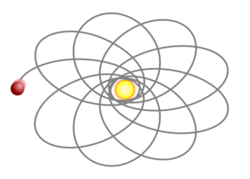Astronomy:Rosetta orbit
A Rosetta orbit is a complex type of orbit.
In astronomy, a Rosetta orbit occurs when there is a periastron shift during each orbital cycle. A retrograde Newtonian shift can occur when the central mass is extended rather than a point gravitational source, resulting in a non-closed orbit. A prograde relativistic shift happens because of relativistic effects from a massive gravitational source.[1] In barred spiral galaxies with a compact, lens-shaped bar (in contrast with a box-shaped bar), the morphology of the bar is supported by stars following rosette-shaped orbits that rotate with the bar.[2]
An object approaching a black hole with an intermediate velocity (not slow enough to spiral into the hole and not fast enough to escape) enters a complex orbit pattern, bounded by a near and far distance to the hole and tracing an oscillating pattern known as a hypotrochoid. In 2020, scientists using observations made by the European Southern Observatory's Very Large Telescope revealed for the first time that star S2 orbits in this pattern around Sagittarius A*.[3][4]
In quantum mechanics, the Rosetta orbit is a solution for spherically symmetric (except 1/r) potentials.
See also
References
- ↑ Rubilar, G. F.; Eckart, A. (July 2001). "Periastron shifts of stellar orbits near the Galactic Center". Astronomy and Astrophysics 374: 95–104. doi:10.1051/0004-6361:20010640. Bibcode: 2001A&A...374...95R.
- ↑ Smirnov, Anton A. et al. (April 2021). "Face-on structure of barlenses and boxy bars: an insight from spectral dynamics". Monthly Notices of the Royal Astronomical Society 502 (4): 4689–4707. doi:10.1093/mnras/stab327. Bibcode: 2021MNRAS.502.4689S.
- ↑ "ESO telescope sees star dance around supermassive black hole, proves Einstein right". ScienceDaily. 2020-04-16. https://www.sciencedaily.com/releases/2020/04/200416072638.htm.
- ↑ Jennifer Leman (2020-04-16). "Weird Black Hole-Orbiting Star Proves Einstein Right (Again)". Popular Mechanics. https://www.popularmechanics.com/space/deep-space/a32172691/black-hole-orbiting-star-einstein-general-relativity/.
External links
 |


